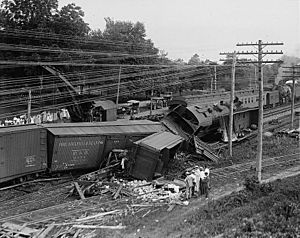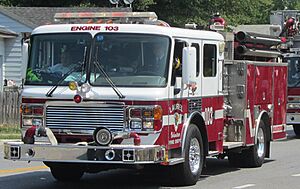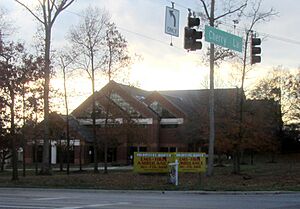Laurel, Maryland facts for kids
Quick facts for kids
Laurel, Maryland
|
|||
|---|---|---|---|
| City of Laurel | |||
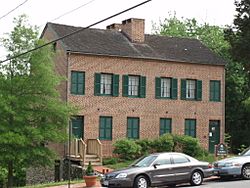
The Laurel Museum in May 2007
|
|||
|
|||
| Motto(s):
"Progressio Per Populum"
(English: Progress Through People) |
|||
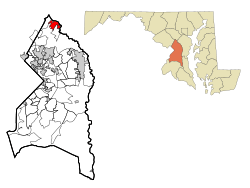
Location of Laurel in Prince George's County and Maryland
|
|||
| Country | |||
| State | |||
| County | Prince George's | ||
| Incorporated | 1870 | ||
| Area | |||
| • Total | 4.84 sq mi (12.53 km2) | ||
| • Land | 4.82 sq mi (12.47 km2) | ||
| • Water | 0.02 sq mi (0.06 km2) | ||
| Elevation | 164 ft (50 m) | ||
| Population
(2020)
|
|||
| • Total | 30,060 | ||
| • Density | 6,242.99/sq mi (2,410.60/km2) | ||
| Time zone | UTC−5 (EST) | ||
| • Summer (DST) | UTC−4 (EDT) | ||
| ZIP codes |
20707–20709, 20723–20726
|
||
| Area code(s) | 240, 301 | ||
| FIPS code | 24-45900 | ||
| GNIS feature ID | 0597667 | ||
| Website | cityoflaurel.org | ||
Laurel is a city in Maryland, United States. It's located between Washington, D.C. and Baltimore. The city sits on the banks of the Patuxent River in northern Prince George's County.
Laurel started as a mill town in the early 1800s. It grew with local industries and became a place where people lived and traveled to work in Washington and Baltimore. This happened after the Baltimore and Ohio Railroad arrived in 1835. Today, Laurel is mostly a residential city. It has a historic district on its Main Street that shows its industrial past.
The Department of Defense has a big presence in the Laurel area. Nearby are the Fort Meade Army base, the NSA, and Johns Hopkins' Applied Physics Laboratory. Laurel Park, a horse racetrack, is also close by.
Contents
- Laurel's History: From Dinosaurs to Today
- Laurel's Location and Climate
- Who Lives in Laurel?
- Getting Around Laurel: Roads, Trains, and Buses
- Keeping Laurel Safe: Emergency Services
- Laurel's Media and Culture
- Learning in Laurel: Schools and Libraries
- Fun and Games: Sports and Recreation in Laurel
- Famous People from Laurel
- Images for kids
- See also
Laurel's History: From Dinosaurs to Today
Ancient History: Dinosaurs in Laurel
Did you know that many dinosaur fossils from the Cretaceous Era have been found in Laurel? There's a special 7.5-acre (3.0 ha) park in Laurel where these fossils are preserved. Scientists have found fossilized teeth from dinosaurs like Astrodon and Priconodon here. This site is known as one of the best places to find dinosaur fossils in the eastern United States.
Long ago, around 10,700 B.C., Laurel's climate changed. It went from a cold spruce forest to a warmer hardwood forest. Later, from 4,000 to 1,000 B.C., Laurel was mostly covered with oak and hickory trees.
Early Days: How Laurel Began
Laurel started on land along the Patuxent River. This land was first claimed by the Snowden family in 1658. A major road, Route 1, was built between 1796 and 1812. Even George Washington used to travel on it!
Around 1811, Nicholas Snowden built a grist mill here. It later became a small cotton mill by the 1820s. In 1835, the B&O railroad opened a line from Baltimore to Washington. This helped the mill grow a lot. The Patuxent Manufacturing Company expanded the mill and built homes for nearly 300 workers.
Laurel was first called "Laurel Factory" in 1837. It was a "company town," meaning the mill company owned many of the workers' homes and even had a school and shops. By the 1840s, three important churches were built: Methodist, Roman Catholic, and Episcopal.
During the American Civil War, Laurel was a divided town. Some people supported the North, and others supported the South. Union soldiers guarded the railroad, and there was even a Union hospital for a while.
As the 1800s went on, Laurel changed. It became an early suburban town where many people traveled by train to work in Washington or Baltimore. The town officially became a city in 1870. By 1890, it had grown to 2,080 people. The city even got a new electric power plant and paved streets!
In 1888, an inventor named David J. Weems tested an unmanned electric train near Laurel Station. This three-ton vehicle reached speeds of up to 120 miles per hour!
Laurel in the 1900s
In 1902, electric trolley service began in Laurel. This made it easier for people to get around.
A large hospital called the Laurel Sanitarium was built in 1905. It was located on a 163-acre (0.66 km2) farm.
Laurel Park Racecourse, a horse racetrack, opened in 1911 and is still used today. The famous horse Seabiscuit raced here! From 1948 to 1990, Laurel also had a harness racing track called Freestate Raceway.
In 1912, the city decided to build its first sewer system. In 1913, Laurel was a stop on a Suffrage hike led by Rosalie Gardiner Jones. Women marched to gain the right to vote.
In 1925, Board track racing came to Laurel. A 1.125-mile (1.811 km) wooden oval track was built for car races. It had very steep turns! Even though up to 30,000 people came to watch, the track didn't last long.
In 1954, the Johns Hopkins Applied Physics Laboratory built its campus nearby. By 1960, Laurel was expecting a lot of growth because of Fort Meade and the NSA.

In 1972, Hurricane Agnes caused the biggest flooding ever in Maryland. Laurel was hit hard, and several bridges were destroyed. In 1975, the city created a historic district around Main Street to protect its old buildings.
The Laurel Museum opened on May 1, 1996. It's in a renovated mill worker's home from the 1840s. The museum shows the history of Laurel and its people.
Laurel in the 2000s
On September 24, 2001, a tornado hit Laurel. It caused a lot of damage, including to Laurel High School.
In 2005, Laurel became a sister city with Laurel, Mississippi. This was to help with relief and recovery after Hurricane Katrina. Laurel, Maryland, raised over $20,000 to help its sister city.
Historic Places to Visit in Laurel
Laurel has many historic sites. Here are some important ones:
| Site name | Image | Location | M-NCPPC Inventory Number | Comment | |
|---|---|---|---|---|---|
| 1 | Avondale Mill (1844–1991) |  |
21 Avondale St. | n/a | Added to the National Register of Historic Places in 1979; destroyed in 1991. |
| 2 | Duvall Bridge | Telegraph Road at Patuxent River, Patuxent Wildlife Research Center | 64-002 | A Pratt truss bridge built in 1907. It used to be on the main route for telegraphs between Baltimore and Washington. | |
| 3 | Laurel High School (original building) / Phelps Community Center |  |
700 block of Montgomery St | n/a | Added to the National Register of Historic Places in 1979. |
| 4 | Laurel Railroad Station |  |
E. Main St | n/a | Designed by architect Ephraim Francis Baldwin and built in 1884. Added to the National Register of Historic Places in 1973. |
| 5 | Montpelier |  |
2.1 mi (3.4 km). S of Laurel on MD 197 | 62-006 | Added to the National Register of Historic Places in 1970. |
| 6 | Oaklands | 8314 Contee Road | 62-003 | ||
| 7 | Snow Hill |  |
S of Laurel off MD 197 | 62-004 | Added to the National Register of Historic Places in 1974. |
| 8 | Snowden Hall |  |
Building 16, Patuxent Wildlife Research Center | 64-001 |
Laurel's Location and Climate
Laurel is located on the bank of the Patuxent River. This river was important because it powered the early cotton mills in the town.
The city uses several ZIP Codes, including 20707, 20708, and 20709. Some nearby communities, like Maryland City, also use the Laurel post office but are not part of the city itself.
Laurel covers about 4.33 square miles (11.21 km2) of land. Most of this is land, with a small amount of water.
Laurel has a Humid subtropical climate. This means it has hot, humid summers and cool to mild winters. It gets a good amount of rain throughout the year.
Who Lives in Laurel?
| Historical population | |||
|---|---|---|---|
| Census | Pop. | %± | |
| 1870 | 1,148 | — | |
| 1880 | 1,206 | 5.1% | |
| 1890 | 1,984 | 64.5% | |
| 1900 | 2,079 | 4.8% | |
| 1910 | 2,415 | 16.2% | |
| 1920 | 2,239 | −7.3% | |
| 1930 | 2,532 | 13.1% | |
| 1940 | 2,823 | 11.5% | |
| 1950 | 4,482 | 58.8% | |
| 1960 | 8,503 | 89.7% | |
| 1970 | 10,525 | 23.8% | |
| 1980 | 12,103 | 15.0% | |
| 1990 | 19,438 | 60.6% | |
| 2000 | 19,960 | 2.7% | |
| 2010 | 25,115 | 25.8% | |
| 2020 | 30,060 | 19.7% | |
| U.S. Decennial Census | |||
According to the 2010 census, 25,115 people lived in Laurel. There were about 10,498 households.
The population of Laurel is made up of many different groups of people. About 30% are White, 49% are African American, and 9% are Asian. About 15.5% of the population is Hispanic or Latino.
The average age in Laurel is about 33.7 years old. About 22.6% of residents are under 18.
Getting Around Laurel: Roads, Trains, and Buses
Roads and Highways in Laurel
The main highway near Laurel is Interstate 95. It runs along the western side of the city. You can get to Laurel from I-95 using Maryland Route 198.
Other important roads include U.S. Route 1, Maryland Route 197, and Maryland Route 216. The Intercounty Connector (MD 200) also starts just south of Laurel. It connects Laurel to Gaithersburg.
Public Transportation in Laurel
Laurel has two MARC train stations: Laurel Station and Laurel Racetrack Station. These trains go to Baltimore and Washington, D.C. The Laurel Station building is a historic landmark.
The Washington Metropolitan Area Transit Authority (WMATA) Metrobus also serves Laurel with several routes. There is also local RTA bus service.
Airports Near Laurel
The main airports for the Laurel area are Baltimore-Washington International Thurgood Marshall Airport (BWI) and Ronald Reagan Washington National Airport (DCA). BWI is in nearby Anne Arundel County, and DCA is close to Washington, D.C.
Keeping Laurel Safe: Emergency Services
The Laurel Police Department and the Prince George's County Police Department help keep the city safe. The Maryland State Police also patrol major roads like US 1 and I-95.
The main fire and rescue services for Laurel come from volunteers. These are the Laurel Volunteer Fire Department (Company 10) and the Laurel Volunteer Rescue Squad (Company 49). The Fire Department was started in 1902. They have fire engines and an aerial tower. The Rescue Squad was formed in 1952. They have rescue vehicles and ambulances.
The University of Maryland Laurel Medical Center provides emergency and outpatient services. It also offers wound care and other medical services.
Laurel's Media and Culture
Media in Laurel
Laurel gets its TV channels from Washington and Baltimore. These include channels like NBC, FOX, ABC, and CBS. Many AM and FM radio stations also reach Laurel.
Laurel has its own local newspaper, the Laurel Leader. It also has a local AM radio station, WACA 900. Residents can also read major newspapers like The Washington Post and The Baltimore Sun.
Arts and Entertainment in Laurel
Laurel has several places for performing arts. These include the Venus Theatre, Laurel Mill Playhouse, and Montpelier Arts Center. The Montpelier Arts Center also has an art gallery.
Fun Events in Laurel
The city of Laurel hosts several fun events each year.
- LakeFest: Held in May.
- Independence Day celebration: Held in July.
- Main Street Festival: Since 1981, the Laurel Board of Trade has sponsored this festival in May.
- RiverFest: Held in October since 1995.
- Montpelier Mansion Festival: An annual festival held in May, focusing on herbs, tea, and arts.
Learning in Laurel: Schools and Libraries
Public Schools in Laurel
Prince George's County Public Schools serves students in Laurel.
- Elementary Schools: Laurel Elementary School and Scotchtown Hills Elementary School are in the city. Some students also go to nearby schools like Bond Mill, Deerfield Run, and Oaklands.
- Middle Schools: Dwight D. Eisenhower Middle School and Martin Luther King Jr. Middle School serve Laurel.
- High School: Laurel High School is located within the city limits.
In the past, schools were separated by race. Black students from Laurel went to different high schools until around 1964, when this separation ended.
Private Schools in Laurel
Laurel has several private schools, including:
- Augsburg Academy (Christian Day School)
- Faith Baptist Christian School
- First Baptist School of Laurel
- Julia Brown Montesorri School
- Kiddie Academy of Laurel
- Kiddies Kollege Christian Center
- Laurel Baptist Academy
- Pallotti Day Care Center (Catholic)
- St. Mary of the Mills School (Catholic)
- St. Vincent Pallotti High School (Catholic high school)
Colleges and Libraries in Laurel
Prince George's Community College and Howard Community College share a campus in Laurel called the Laurel College Center.
Capitol Technology University is located south of Laurel.
For reading and research, the Prince George's County Memorial Library System operates the Laurel Branch Library. There are also nearby libraries in Anne Arundel County and Howard County.
Fun and Games: Sports and Recreation in Laurel
Laurel's Department of Parks & Recreation offers sports leagues for adults. Kids can join leagues like Laurel Little League and Greater Laurel United Soccer Club.
The city has eleven parks, three athletic fields, and three community centers. There's also a city swimming pool and tennis courts.
The Fairland Sports and Athletic Complex is just outside the city. It has swimming, gymnastics, tennis, and more.
The Gardens Ice House is a skating facility with three ice rinks. You can go ice skating, figure skating, or play hockey there. It's also home to the Washington Jr. Nationals ice hockey team.
The Laurel Roller Skating Center is just north of the city. It's a great place for public roller skating.
Famous People from Laurel
Many interesting people have connections to Laurel:
- Simon Cho – An Olympic short track speed skater.
- Jim Clash – A journalist who writes about adventures.
- R. Orin Cornett – A physicist who invented Cued speech for the deaf.
- Edith DeVoe – The first Black nurse in the regular U.S. Navy.
- Future president Dwight D. Eisenhower and his wife Mamie Eisenhower lived in Laurel for a short time in 1919.
- Marty Friedman – Former lead guitarist for the band Megadeth; he went to Laurel High School.
- Kathleen Hanna – A band member of Bikini Kill and Le Tigre; she went to O.W. Phair Elementary School in Laurel.
- Ernest Lyon – A former U.S. Ambassador to Liberia.
- Biz Markie – A famous rap artist.
- Andrew Maynard – A boxer who won a gold medal at the 1988 Summer Olympics; he was born in Laurel.
- Greg Merson – The winner of the 2012 World Series of Poker Main Event.
- Yvonne Orji – An actor and comedian.
- Visanthe Shiancoe – A former National Football League tight end.
- Ron Turcotte – A Hall of Fame horse jockey who trained at Laurel Park.
- DeWanda Wise – An actor.
Images for kids
See also
 In Spanish: Laurel (Maryland) para niños
In Spanish: Laurel (Maryland) para niños






